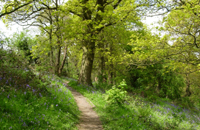Staff from SNH and Stirling Council found a number of young ash saplings showing symptoms of chalara at Balquhidderock Site of Special Scientific Interest (SSSI) in Stirling.
Lab tests carried out by Forest Research at their Northern Research Station at Roslin have now confirmed chalara in two of the samples. At this stage no mature trees have been confirmed as having the infection. The disease is spread via airborne spores.
Balquhidderock is privately owned but is managed by Stirling Council with much of the work being done by volunteers from the Balquhidderock Wood Conservation Group. There are two volunteer wardens at the wood, which as well as being a local nature reserve, is used for school educational visits and as a recreation area for walkers.
Susan Davies, SNH’s director of policy and advice, said: “This is the first known case of infection in a nature protected area in Scotland. Whilst not unexpected it is disappointing. We are working closely with Forestry Commission Scotland and others, including Stirling Council, to establish the scale of the infection and to implement the action required.
“Action is likely to involve the removal of smaller infected saplings but mature trees will be left, unless they pose an imminent safety risk. Mature trees are left because they have an important biodiversity value and may yet be found to have resistance to the disease.”

